| 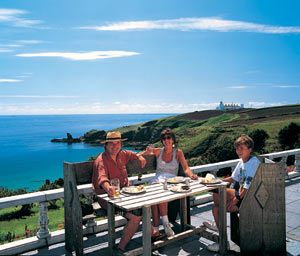 The
Lizard Peninsula is unique. Stunningly beautiful at any time of the year, there
is nowhere quite like it anywhere else in Britain. It is for this reason that
the Lizard has been a continuing source of inspiration for artists and writers.
Almost surrounded by the sea, the peninsula stands alone, in a very real sense,
from the rest of the county. In a line from London to Land’s End, the backbone
of Cornwall is a route to somewhere. The
Lizard Peninsula is unique. Stunningly beautiful at any time of the year, there
is nowhere quite like it anywhere else in Britain. It is for this reason that
the Lizard has been a continuing source of inspiration for artists and writers.
Almost surrounded by the sea, the peninsula stands alone, in a very real sense,
from the rest of the county. In a line from London to Land’s End, the backbone
of Cornwall is a route to somewhere. The
Lizard. Not a cross-roads, a junction, or a place to drive through, but a journey’s
end, a destination. Standing proud in the sea, the peninsula presents a rugged
face to the elements, yet paradoxically the climate is probably the warmest in
Britain. The air is crisp, clear and unpolluted by industry. The rocks and cliffs
of the coastline offer shelter to the tiny fishing villages huddled into their
coves, looking now much as they did centuries ago. Small
cottages, thatched and whitewashed, cluster around tiny harbours. Colourful fishing
boats, pulled up on the beach, bear testimony to the fact that these small communities
still depend largely on the sea for their livelihood.
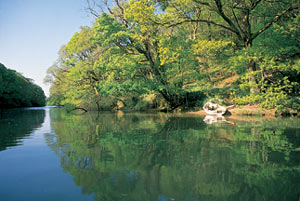 Winter
is a quiet time here. The fishermen’s choirs sing in their local pubs, and the
harbours are decorated with lights and lanterns for Christmas. Big log fires keep
out the chill from the sea when the evenings draw in. Inland, the moors of the
peninsula are criss-crossed by tiny country lanes, wide open spaces spread thick
with heather, and dotted casually with Celtic landmarks. It is an ancient place,
where history is indelibly inscribed on the landscape. For these reasons, the
Lizard Peninsula has been designated an Area of Outstanding Natural Beauty. It
is recognised as being of international botanical importance - and here you can
find 15 of Britain’s rarest plants! Winter
is a quiet time here. The fishermen’s choirs sing in their local pubs, and the
harbours are decorated with lights and lanterns for Christmas. Big log fires keep
out the chill from the sea when the evenings draw in. Inland, the moors of the
peninsula are criss-crossed by tiny country lanes, wide open spaces spread thick
with heather, and dotted casually with Celtic landmarks. It is an ancient place,
where history is indelibly inscribed on the landscape. For these reasons, the
Lizard Peninsula has been designated an Area of Outstanding Natural Beauty. It
is recognised as being of international botanical importance - and here you can
find 15 of Britain’s rarest plants!
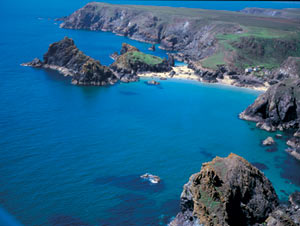 The
warm local climate has led to the abundant growth of sub-tropical vegetation,
and a constant profusion of colour all year round. Where else do primroses flower
before Christmas, or camellias open in December? Daffodils often decorate the
hedgerows in January, to be followed closely by a myriad of other wild flowers,
the abundance of which is rarely seen elsewhere. The
warm local climate has led to the abundant growth of sub-tropical vegetation,
and a constant profusion of colour all year round. Where else do primroses flower
before Christmas, or camellias open in December? Daffodils often decorate the
hedgerows in January, to be followed closely by a myriad of other wild flowers,
the abundance of which is rarely seen elsewhere.
Ferns and palm trees, tree ferns and giant rhubarb are no rarity along the shores
of the thickly wooded Helford river. In summer the riot of blooms and colour in
all the cottage gardens is simply overwhelming; truly an experience at any time
of the year. There
is much organic farming on the Lizard, and locally grown, or caught, food is served
in many restaurants, pubs and hotels. Local crab, lobster, or a huge cream tea
is hard to better.
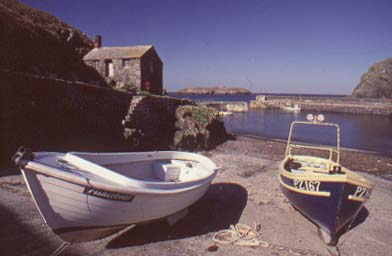 The
south west coast path winds its way round the peninsula, through the changing
scenery, providing exceptionally beautiful walks. Much of the area is owned and
managed by the National Trust, whose Enterprise Neptune campaign ensures that
it remains unspoilt. The peninsula is full of contrasts; flat grassy paths wind
across the clifftops from Mullion, with breathtaking views of Kynance Cove, along
to the dramatic cliffs of Lizard Point, while to the east the softer, greener
landscape of the Helford presents another face of this extraordinary region. The
south west coast path winds its way round the peninsula, through the changing
scenery, providing exceptionally beautiful walks. Much of the area is owned and
managed by the National Trust, whose Enterprise Neptune campaign ensures that
it remains unspoilt. The peninsula is full of contrasts; flat grassy paths wind
across the clifftops from Mullion, with breathtaking views of Kynance Cove, along
to the dramatic cliffs of Lizard Point, while to the east the softer, greener
landscape of the Helford presents another face of this extraordinary region.
Tourism is low key and
individual here. We still have time to talk, and time to live, at any time of
the year. There is no pressure to "do things". You can be as active or as lazy
as you like. Sail from the Helford, walk, surf or windsurf, go horse riding, play
golf on the superb course at Mullion, or laze and swim from any of the beautiful
beaches and coves. There are so many gardens to visit that you will be spoilt
for choice. Join a village barbecue or take a fishing trip with a local boat from
Cadgwith. Or just soak up the charm and solitude of this enchanted region. But
beware - it is very addictive! |
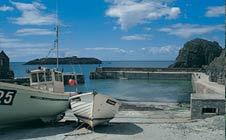
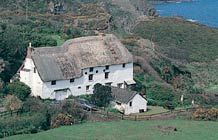
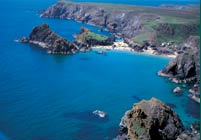
 The
Lizard Peninsula is unique. Stunningly beautiful at any time of the year, there
is nowhere quite like it anywhere else in Britain. It is for this reason that
the Lizard has been a continuing source of inspiration for artists and writers.
Almost surrounded by the sea, the peninsula stands alone, in a very real sense,
from the rest of the county. In a line from London to Land’s End, the backbone
of Cornwall is a route to somewhere.
The
Lizard Peninsula is unique. Stunningly beautiful at any time of the year, there
is nowhere quite like it anywhere else in Britain. It is for this reason that
the Lizard has been a continuing source of inspiration for artists and writers.
Almost surrounded by the sea, the peninsula stands alone, in a very real sense,
from the rest of the county. In a line from London to Land’s End, the backbone
of Cornwall is a route to somewhere.  Winter
is a quiet time here. The fishermen’s choirs sing in their local pubs, and the
harbours are decorated with lights and lanterns for Christmas. Big log fires keep
out the chill from the sea when the evenings draw in. Inland, the moors of the
peninsula are criss-crossed by tiny country lanes, wide open spaces spread thick
with heather, and dotted casually with Celtic landmarks. It is an ancient place,
where history is indelibly inscribed on the landscape. For these reasons, the
Lizard Peninsula has been designated an Area of Outstanding Natural Beauty. It
is recognised as being of international botanical importance - and here you can
find 15 of Britain’s rarest plants!
Winter
is a quiet time here. The fishermen’s choirs sing in their local pubs, and the
harbours are decorated with lights and lanterns for Christmas. Big log fires keep
out the chill from the sea when the evenings draw in. Inland, the moors of the
peninsula are criss-crossed by tiny country lanes, wide open spaces spread thick
with heather, and dotted casually with Celtic landmarks. It is an ancient place,
where history is indelibly inscribed on the landscape. For these reasons, the
Lizard Peninsula has been designated an Area of Outstanding Natural Beauty. It
is recognised as being of international botanical importance - and here you can
find 15 of Britain’s rarest plants!  The
warm local climate has led to the abundant growth of sub-tropical vegetation,
and a constant profusion of colour all year round. Where else do primroses flower
before Christmas, or camellias open in December? Daffodils often decorate the
hedgerows in January, to be followed closely by a myriad of other wild flowers,
the abundance of which is rarely seen elsewhere.
The
warm local climate has led to the abundant growth of sub-tropical vegetation,
and a constant profusion of colour all year round. Where else do primroses flower
before Christmas, or camellias open in December? Daffodils often decorate the
hedgerows in January, to be followed closely by a myriad of other wild flowers,
the abundance of which is rarely seen elsewhere.  The
south west coast path winds its way round the peninsula, through the changing
scenery, providing exceptionally beautiful walks. Much of the area is owned and
managed by the National Trust, whose Enterprise Neptune campaign ensures that
it remains unspoilt. The peninsula is full of contrasts; flat grassy paths wind
across the clifftops from Mullion, with breathtaking views of Kynance Cove, along
to the dramatic cliffs of Lizard Point, while to the east the softer, greener
landscape of the Helford presents another face of this extraordinary region.
The
south west coast path winds its way round the peninsula, through the changing
scenery, providing exceptionally beautiful walks. Much of the area is owned and
managed by the National Trust, whose Enterprise Neptune campaign ensures that
it remains unspoilt. The peninsula is full of contrasts; flat grassy paths wind
across the clifftops from Mullion, with breathtaking views of Kynance Cove, along
to the dramatic cliffs of Lizard Point, while to the east the softer, greener
landscape of the Helford presents another face of this extraordinary region.